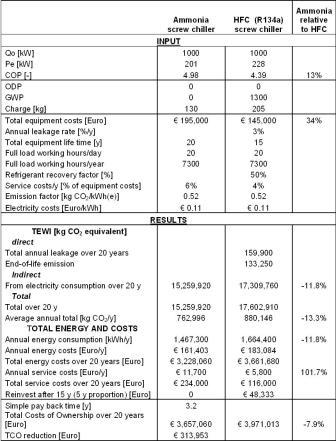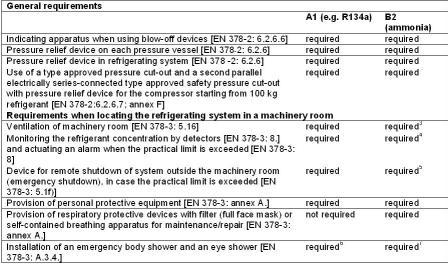Packaged chillers with ammonia as a refrigerant: the natural choice
- Like
- Digg
- Del
- Tumblr
- VKontakte
- Buffer
- Love This
- Odnoklassniki
- Meneame
- Blogger
- Amazon
- Yahoo Mail
- Gmail
- AOL
- Newsvine
- HackerNews
- Evernote
- MySpace
- Mail.ru
- Viadeo
- Line
- Comments
- Yummly
- SMS
- Viber
- Telegram
- Subscribe
- Skype
- Facebook Messenger
- Kakao
- LiveJournal
- Yammer
- Edgar
- Fintel
- Mix
- Instapaper
- Copy Link
Posted: 6 September 2012 | René van Gerwen, Global Lead Engineer Refrigeration & HVAC, Unilever Engineering Services | 1 comment
Industrial chillers for the supply of chilled water, cold glycol or brine, are frequently used over a long time, and have become even more attractive for several applications to replace direct refrigeration systems. Greenhouse gas footprint and lifecycle costs of ownership of industrial chillers can be significantly reduced by using ammonia as a refrigerant, instead of the traditionally used HFCs. Ammonia does not contribute to ozone depletion nor global warming and ammonia chillers are generally more energy efficient than equivalent HFC chillers. Packaged chillers, using ammonia as a refrigerant, are currently available from several suppliers.
On the basis of supplier information, com – parisons have been made between a typical packaged ammonia chiller and an equivalent HFC chiller, confirming that packaged ammonia chillers are an attractive and feasible alternative for conventional HFC chillers, particularly in industrial applications. As the chiller community is unfamiliar with ammonia as a refrigerant, more standardisation in safety regulations, equipment and housing details, simplified operation and maintenance procedures and lower equipment costs may further help in accelerating the wider use of the natural refrigerant ammonia in this new application area.
Industrial chillers for the supply of chilled water, cold glycol or brine, are frequently used over a long time, and have become even more attractive for several applications to replace direct refrigeration systems. Greenhouse gas footprint and lifecycle costs of ownership of industrial chillers can be significantly reduced by using ammonia as a refrigerant, instead of the traditionally used HFCs. Ammonia does not contribute to ozone depletion nor global warming and ammonia chillers are generally more energy efficient than equivalent HFC chillers. Packaged chillers, using ammonia as a refrigerant, are currently available from several suppliers. On the basis of supplier information, com - parisons have been made between a typical packaged ammonia chiller and an equivalent HFC chiller, confirming that packaged ammonia chillers are an attractive and feasible alternative for conventional HFC chillers, particularly in industrial applications. As the chiller community is unfamiliar with ammonia as a refrigerant, more standardisation in safety regulations, equipment and housing details, simplified operation and maintenance procedures and lower equipment costs may further help in accelerating the wider use of the natural refrigerant ammonia in this new application area.
Industrial chillers for the supply of chilled water, cold glycol or brine, are frequently used over a long time, and have become even more attractive for several applications to replace direct refrigeration systems. Greenhouse gas footprint and lifecycle costs of ownership of industrial chillers can be significantly reduced by using ammonia as a refrigerant, instead of the traditionally used HFCs. Ammonia does not contribute to ozone depletion nor global warming and ammonia chillers are generally more energy efficient than equivalent HFC chillers. Packaged chillers, using ammonia as a refrigerant, are currently available from several suppliers.
On the basis of supplier information, com – parisons have been made between a typical packaged ammonia chiller and an equivalent HFC chiller, confirming that packaged ammonia chillers are an attractive and feasible alternative for conventional HFC chillers, particularly in industrial applications. As the chiller community is unfamiliar with ammonia as a refrigerant, more standardisation in safety regulations, equipment and housing details, simplified operation and maintenance procedures and lower equipment costs may further help in accelerating the wider use of the natural refrigerant ammonia in this new application area.
Packaged industrial chillers provide chilled water, glycol or brine (called secondary refrigerants, cooling media or coolants). Chilled water, glycol or brine can be used for air conditioning purposes (e.g. to circulate through the cooling coil of air handling units in HVAC systems) or in processes (e.g. for a variety of manufacturing processes in food and non-food). Traditionally, these packaged chillers use CFCs, HCFCs or HFCs as a refrigerant. CFC and HCFC are in a phase out stage, due to their contri – bution to ozone depletion. Today, HFCs (e.g. R407C, R404A, R507, R134a, R410A) are comm – only used as refrigerants in chillers. As there is uncertainty about the future of HFCs due to their very high global warming potential (GWP, being 1300-3300 times the GWP of CO2 for most of the HFCs), a new generation of low-GWP HFC alternatives (HFO) are currently entering the market. However, there is also uncertainty about the future and desirability of these HFO alternatives. For that reason, there is an increasing interest in natural refrigerants, like ammonia, hydrocarbons, carbon dioxide, water and air.
Several leading refrigeration end-user companies in the fast moving consumer goods (FMCG) sector therefore made the choice for natural refrigerants in their refrigerant applications, and several companies have joined forces in alliances like Refrigerants Naturally!, supported by Greenpeace and UNEP2.
For packaged chillers, particularly the larger versions used in manufacturing sites, ammonia is the preferred natural refrigerant. Ammonia has proven to be fully environmentally benign, and the preferred refrigerant in industrial process refrigeration and for cold stores over the last century. Industrial chillers, using HFC as refrigerant, significantly contribute to greenhouse gas emissions. This contribution is related to the emissions of the refrigerant (leakage), as well as to the electricity con – sumption for running these chillers. In order to reduce both elements of this contribution, efficient chillers with ammonia as a refrigerant may be applied as a potential alternative for these HFC chillers. Unilever encourages a wider use of these ammonia chillers, on the basis of several investigations and comparisons, performed by Unilever Engineering Services in close cooperation with several chiller suppliers. Details of a comparative study are provided in3.
Chillers, direct and indirect refrigeration
The purpose of a chiller is to cool a secondary refrigerant, where this secondary refrigerant circulates in a closed circuit with pumps, valves and heat exchangers, in order to finally cool air or processes. Depending on the conditions of the air or process (e.g. temperature), a variety of secondary refrigerants can be used, e.g. water, glycol, brine. The choice of secondary refrigerant is determined by its application and almost independent from the chiller design. This is in contrast to direct refrigeration systems (direct expansion, DX), where the refrigerant is circulating to and from the applications (air coolers, processing equipment), without the use of a secondary refrigerant circuit.
Indirect systems have several advantages. There is the possibility to drastically reduce refrigerant charge, down to 5 – 15 per cent of the charge in a direct system. This may reduce atmospheric emissions, traditionally caused by 10 – 30 per cent annual leakage of the refrigerant charge for direct systems. Almost all welding and brazing/soldering of the refrigerant circuit can be made under factory conditions which reduces the risk of refrigerant leakage down to one to five per cent. Refrigerants can be easily used in a controlled and safe way, as a limited refrigerant charge can be contained in a packaged system and its housing. Indirect systems also allow more standardisation, simplification and flexibility of the total system and its control, operation and maintenance, driving total costs of ownership down.
There are also certain drawbacks related to indirect systems. There is an increased cost for secondary fluids, pumps, piping and extra heat exchangers for the secondary circuits. Extra pump drive energy is required for the secondary circuit. Extra heat exchanger in the secondary circuit adds an additional temperature difference between the evapora – ting refrigerant and the object to be cooled, decreasing the efficiency (COP) of the refrigeration process. A careful design and good quality of controls and operation are often able to minimise these drawbacks. There is an obvious trend that indirect systems with chillers will become increasingly important as an alternative to direct refrigeration systems, because of their advantages.
Major chiller components
Compressors
A variety of compressor types are used in chillers currently on the market, depending on application, size and refrigerant. For industrial chillers, normally above 300 kW refrigeration design capacity, rotary (screw) compressors are the preferred choice. A few suppliers use turbo compressors, with high peak efficiency but also certain disadvantages, and therefore not widely applicable.
Condenser section
There are basically three different types of condenser sections:
- Water cooled condenser: The heat exchanger can be of the shell–and-tube, plate or plate-in-shell type. The water circuit can be connected to an open or closed cooling tower, to river or ground water, or to a heat recovery system
- Air cooled condenser: This is the most common condenser type for traditional HFC chillers
- Evaporative condenser: This is the most common condenser type for process refrigeration, where the latent cooling effect from the ambient air can be utilised to further reduce the condensing pressure
When using a water cooled condenser, the refrigerant charge can be minimised and contained within the housing of the chiller.
Condenser pressure control for chillers is traditionally on the basis of a fixed setting. Depending on ambient condition fluctuations and load requirements, significant energy saving can be obtained by applying floating condensing pressure controls.
Evaporator and expansion section
The evaporator can be of the shell–and-tube, plate or plate-in-shell type. Expansion can be of the dry controlled type, using a thermostatic or electronic expansion valve, as in most of the HFC chillers. The alternative concept, as normally used for ammonia chillers, is the flooded evaporator type with gravity or pump (overfeed) circulation in combination with a suction separator vessel or device.
Chiller comparison
A typical ammonia chiller has been compared with a typical HFC-based chiller.
When comparing two chiller concepts, this should be done in a ‘like-by-like’, fair and realistic way. Extensive equipment data have been obtained from several chiller suppliers, as well as from field applications. As expected, the provided data were based on a variety of assumptions, conditions and sometimes showed inconsistencies. On the basis of a thorough analysis of all these data, two comparable typical chiller concepts have been defined, where the data can be compared in a reasonable way. Both typical chillers are packaged and skid mounted in a standard housing. Dimensions of the ammonia packages largely differ depending on supplier and design details. In general, ammonia chiller packages are slightly more voluminous and heavy than equivalent HFC chillers. However, modern design ammonia chillers do not differ much from HFC ones. Both chillers use screw compressors with variable speed drives on compressor motors.
Comparison has been made on the basis of design (full load) conditions, which are relatively easy and robust, and cumulative annual full-load running hours. Fluctuating climate and load conditions have similar influence on both types. As refrigerants, ammonia and HFC R134a are selected. Both chillers supply standard chilled water at design temperature of 7°C and return water at 12°C, by using plate evaporators. The ammonia chiller uses a flooded evaporator; the HFC chiller is equipped with an advanced electronic expansion valve for direct expansion. Design refrigeration capacity is 1000 kW. A typical water cooled plate condenser, with cooling water temperature of 30/35°C., in combination with a cooling tower is used for both chiller types. Typical realistic equipment costs are chosen, where the ammonia chiller safety provisions, according to European refrigeration standard EN 378, are included. The longer lifetime of ammonia equipment is taken into account, as well as higher service costs for ammonia chillers. Typical figures for electricity costs, indirect CO2 emissions from electricity production, refrigerant leakage rates and costs are chosen for the comparison. Comparison is based on a 20 year outlook, being the expected total lifetime of an ammonia chiller. Comparison results are provided in Table 1.
Ammonia chiller safety Safety requirements and regulations for refrigeration systems and refrigerants are not globally harmonised. Most European countries have slightly different regulations, largely based on European standard EN 378, containing a classification for refrigerants, systems, locations and charges, based on practical (concentration) limits. Table 2 presents the practical (concentration) limits from EN 378-1:2008+A1:2010.
By using these practical limits, the maximum amount of refrigerant to be released in a confined space determines the maximum equipment size (charge) in a given space, and the required safety provisions. Charge thresholds determine required safety provisions, as illustrated in Table 3, extracted from same EN 378. This table is for illustration only. For all details, refer to the latest version of EN 378.
In general, housings or machinery rooms for ammonia chillers should preferably be provided with ventilation for emergency and temperature control purposes, refrigerant detectors, emergency (remote) shutdown, and personal protective equipment.
Reputable suppliers of ammonia chillers provide cost-effective standard skid mounted packaged chillers in self-contained housings, complying with applicable local safety regulations. More standardisation in equipment, housing and regulations is desired however, and may help in driving costs for ammonia chillers further down.
In case of more stringent safety require – ments, e.g. in residential areas, hospitals or shopping centres, an ammonia vapour scrubber can be applied on the exhaust of the emergency ventilation and pressure relief vent line (water spraying device) to further minimise atmos – pheric emissions.
Operation of ammonia chillers requires similar skills as for HFC chillers, combined with additional ammonia safety awareness. Maintenance, in particular when opening the refrigerant circuit, needs to be done by specialised technicians, for both ammonia as well as HFC (EU F-gas emissions Regulation).
Conclusions
Packaged ammonia chillers are an attractive and feasible alternative for conventional HFC chillers, particularly in industrial applications. More standardisation in safety regulations, equipment and housing details, simplified operation and maintenance procedures and lower equipment costs, may further help in accelerating the wider use of the natural refrigerant ammonia in this new application area.
Acknowledgements
The author acknowledges several equipment suppliers, in particular GEA Refrigeration Technologies (Mr Leenhouts, The Netherlands), Johnson Controls Inc. (Mr Jensen and Mr Cohr Pachai, Denmark), and Zudek (Mr Zudek, Italy), for their valuable contributions and delivery of equipment data and pictures.
References
1. Unilever Sustainable Living Plan: http://www.sustainable-living.unilever.com
2. Refrigerants Naturally!: http://www.refrigerantsnaturally.com
3. R. van Gerwen and S. Raha: industrial chillers with ammonia as refrigerant: an end-user perspective; 10th IIR Gustav Lorentzen Conference on Natural Refrigerants, Delft, The Netherlands, 2012
About the author
Since 2000, René van Gerwen has been Global (Group) Lead Engineer and Specialist for R/HVAC (Refrigeration, Heating, Ventilation & Air Conditioning) in Unilever, part of Unilever Engineering Services (UEnS), based in Vlaardingen, The Netherlands and Mumbai, India. His responsibilities at Unilever include coordinating engineering design and project execution, leading ammonia safety management, sustainability (refrigerants, energy), technology innovation, supplier/ contractor relationships, refrigerated point-of-sales equipment design and improvement, internal specialist training, leading internal networks and external representation. He holds an MSc in Mechanical Engineering (R/HVAC) from Delft University.
Issue
Related topics
Refrigeration and freezing, Shelf life, Technology & Innovation













That is really interesting that ammonia doesn’t contribute to ozone depletion or global warming and are generally more energy efficient. That is something that I would like to have if I need a type of cooling machine. Going green and saving energy is what I have been all about lately and I want to keep it up.